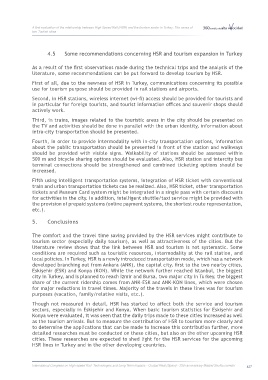Page 429 - 360.revista de Alta Velocidad - Nº 5
P. 429
A first evaluation of the relationship between High Speed Rail (HSR) and the tourism sector in Turkey: The cases of
two Turkish cities
4.5 Some recommendations concerning HSR and tourism expansion in Turkey
As a result of the first observations made during the technical trips and the analysis of the
literature, some recommendations can be put forward to develop tourism by HSR.
First of all, due to the newness of HSR in Turkey, communications concerning its possible
use for tourism purpose should be provided in rail stations and airports.
Second, in HSR stations, wireless internet (wi-fi) access should be provided for tourists and
in particular for foreign tourists, and tourist information offices and souvenir shops should
actively work.
Third, in trains, images related to the touristic areas in the city should be presented on
the TV and activities should be done in parallel with the urban identity, information about
intra-city transportation should be presented.
Fourth, in order to provide intermodality with in-city transportation options, information
about the public transportation should be presented in front of the station and walkways
should be provided with visible signs. Walkability of stations should be assessed within
500 m and bicycle sharing options should be evaluated. Also, HSR station and intercity bus
terminal connections should be strengthened and combined ticketing options should be
increased.
Fifth using intelligent transportation systems, integration of HSR ticket with conventional
train and urban transportation tickets can be realized. Also, HSR ticket, other transportation
tickets and Museum Card system might be integrated in a single pass with certain discounts
for activities in the city. In addition, intelligent shuttle/taxi service might be provided with
the provision of prepaid systems (online payment systems, the shortest route representation,
etc.).
5. Conclusions
The comfort and the travel time saving provided by the HSR services might contribute to
tourism sector (especially daily tourism), as well as attractiveness of the cities. But the
literature review shows that the link between HSR and tourism is not systematic. Some
conditions are required such as touristic resources, intermodality at the rail station, and
local policies. In Turkey, HSR is a newly introduced transportation mode, which has a network
developed branching out from Ankara (ANK), the capital city, first to the two nearby cities,
Eskişehir (ESK) and Konya (KON). While the network further reached Istanbul, the biggest
city in Turkey, and is planned to reach İzmir and Bursa, two major city in Turkey, the biggest
share of the current ridership comes from ANK-ESK and ANK-KON lines, which were chosen
for major reductions in travel times. Majority of the travels in these lines was for tourism
purposes (vacation, family/relative visits, etc.).
Though not measured in detail, HSR has started to affect both the service and tourism
sectors, especially in Eskişehir and Konya. When basic tourism statistics for Eskişehir and
Konya were evaluated, it was seen that the daily trips made to these cities increased as well
as the tourism arrivals. But to measure the contribution of HSR to tourism more clearly and
to determine the applications that can be made to increase this contribution further, more
detailed researches must be conducted on these cities, but also on the other upcoming HSR
cities. These researches are expected to shed light for the HSR services for the upcoming
HSR lines in Turkey and in the other developing countries.
International Congress on High-speed Rail: Technologies and Long Term Impacts - Ciudad Real (Spain) - 25th anniversary Madrid-Sevilla corridor 427

